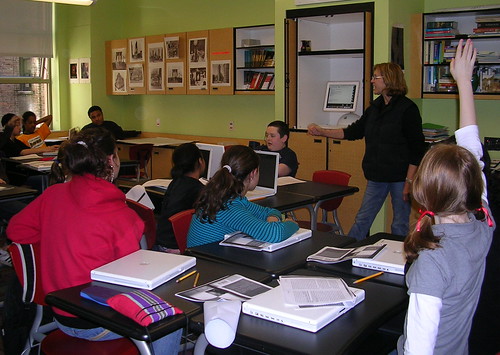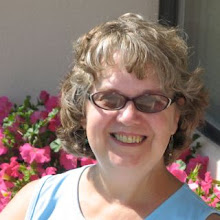Reflectin on Chapters 1-3 from
Tom Newkirk's
"Holding on to Good Ideas in a Time of Bad Ones:
Six Literacy Principles Worth Fighting For."
Tom Newkirk's
"Holding on to Good Ideas in a Time of Bad Ones:
Six Literacy Principles Worth Fighting For."

Most people -- most people who manage-- do not have twenty to thirty of their employees responding to them and interacting together at the same time all day long. Years ago, my husband just reminded me, the optimal number for a manager to manage was seven (7)! Teachers constantly manage a small crowd. In middle and high schools, that crowd changes every fifty minutes. And that's a crowd of children or adolescents. (The video about "herding cats" comes to mind).
Our kids come to us, emotions already tinged by the moment, morning, or night before. They are kids; they don't leave their social baggage behind. In order to manage the crowd, teachers must "take into account the whole situation, including the emotional state of the patient"--- except teachers face twenty to thirty patients at one time for each class. Social needs, social groups, that day's social/emotional group, health needs, personalities, and then learning styles: the teacher is constantly in the "instant," "knowing more than they can describe," taking "intelligent action" ("knowing in action") to manage the crowd and the individuals so the students as a class and as individuals can learn. All the while, the teacher translates the individual student's pattern and needs for learning. Each moment of every class is a dance to the tune of student emotional, physical, and learning needs. Classrooms are "unsettled scores," to which the teacher orchestrates learning. Teachers "know-how is in the action," gathering
and acting on "'micro-theories,' the subtle intuitions and perceptiveness of teachers in the midst of their work."
And some bureaucrat thinks, even though Johnny lost his mom in a car crash two years ago and his dad committed suicide last year, that he will be at the fifth grade level in math, reading, writing, and science just like every other robot they think we teach. The problems kids deal with need not even be through the trauma of losing family, kids are human: their real world is first in their minds; academia floats in when the teacher has alleviated all the physical and social needs. That's what bureaucrats and most outsiders forget. And how the brain learns, how kids learn? Most of them (bureaucrats and outsiders) don't know, but they do know what they want to be done to kids, not for or with kids (kids -- through adolescence). Parents keep teachers tuned to the student; they want teachers to focus on the needs of their kids, which must be done in that small crowd, when we finally have reflection time with colleagues and we can say, "I have this one student..."
After six periods of teaching (after managing small crowds), the time for careful reflection occurs. Actually, that happens after phone calls, after tidying up the classroom, after putting away today's work and preparing for what probably will be the work for tomorrow, and after teaching meetings, (which by now is way past my teacher contract day), now I can analyze the work of the day. For elementary teachers that is a classroom set of data for each subject, or for secondary teachers that's six or seven sets of papers from the different periods in their day-- either way, it's a stack of papers, notes, or online work.
What does productive educational leadership look like?
* Orchestrate with staff a vision for the school that allows each teacher and each student to shine-- differences united
* Orchestrate personal learning networks for teachers and students
* Create the time for teachers to to "frame the case" --to analyze the daily work to fine-tune their "instant" classroom assessment and feedback so each child can learn
* Support and provide resources and professional development from the evidence the teachers bring with what is needed in their classrooms for their kids to learn
* Encourage and support authentic audiences for student projects
* Support art, music, drama, etc.
* Limit the paperwork required for mandates -- for learning, allow teaching, not paper filing
* Understand the whole teacher and the whole child, and let them breathe-- and
* Let classrooms be real -- part of the world and the community
Let them breathe in fresh ideas needed at that moment for each of them-- skipping the teacher's diagnosis for that instant in the crowd denies the needs of a student (times twenty or thirty) over the mandates of today; those mandates will not matter in the future if this learning, today, deemed by the "intelligent action" of the teacher deflates the humanity of our students and turns them from participation in the classroom, the representation of participation in our democracy
Let classrooms be real -- part of the world and the community, an experience of ongoing learning based on the local needs of the community. As John Dewey explained, “Education is not a preparation for life; education is life itself.” We learn and teach the information that is "standard" today, but each child may grow from a different point and from so much more--learning and growing emotionally, socially, academically! --so much more that is not "accountable" in the "proving game" of mandates. However, the students are "improving." Support the teachers' "knowing in action," and support the students' "learning in action." See and support us all as we grow in personal learning networks, life-long learners all.
Think of educational leadership as "I have this one teacher..." and the learning will follow.
[See "Proving While Improving", ASCD Whole Child Newsletter http://www.wholechildeducation.org/resources/newsletter.jhtml?id=37653 ]

Even if we were a Class of Ben: look at the variety!
First blogged here on the English Companion Ning




No comments:
Post a Comment